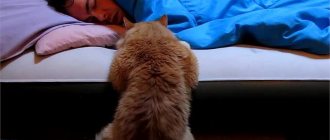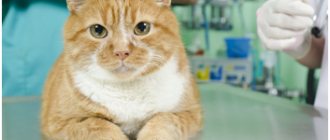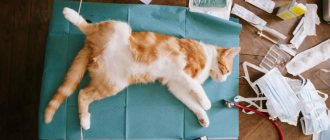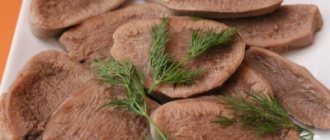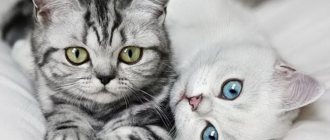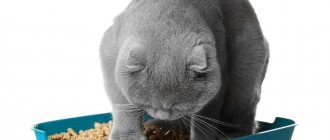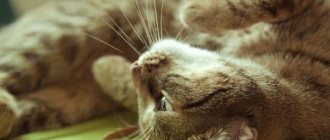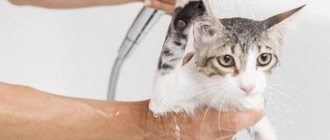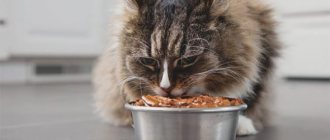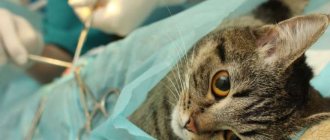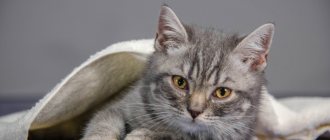Any rehabilitation of a cat after intestinal surgery includes correction of daily nutrition. It is also often difficult for owners to feed a cat that has recently suffered from stomach and other diseases. If your pet does not eat for several days, while its general condition worsens and other pathological symptoms are recorded, then you should immediately contact a veterinarian for help. To maintain the normal condition of a cat during illness, it is possible to feed it liquid food from a syringe and give it water in the same way.
Why does my pet refuse to eat?
When a kitten or adult is sick, the protective mechanisms of the immune system are reduced and the pet often refuses to feed. This reaction is normal for a weakened cat’s body, and owners should not worry too much or force-feed a sick cat. Usually the problem occurs in the first few days after an infection enters the animal’s body and another disease develops. After 2-3 days, the cat may ask for food on its own, or you should try to force-feed it with a small amount of food.
Veterinarians do not recommend allowing prolonged fasting during and after a cat’s illness, since the pet’s strength rapidly decreases and it is more difficult for the sick body to recover.
In most cases, the problem is associated with diseases of the gastrointestinal tract. The treatment process, during which the cat is given various drugs that reduce appetite, can affect impaired feeding. The reason may also be due to other factors:
A stressful state affects the animal's appetite.
- getting a foreign object into the throat or esophagus, which the pet cannot get rid of on its own;
- body bruise of varying severity;
- poisoning of the body;
- impact of stress.
Reasons for refusing to eat?
Do not force-feed your cat unless you know the reasons for refusing food! In many situations, hunger will save your pet from complications. A lot can be said about the reasons for refusing to eat, since there are hundreds of them. Let's look at the most popular ones.
During transition periods - the end of winter, the beginning of summer, the cat may not eat on its own initiative. A healthy cat monitors its weight and loses excess fat before the season in which increased activity is needed. A young cat may refuse to eat due to puberty, hormonal imbalance, fatigue, etc.
If your pet played very actively the day before, jumped, ran, and could not calm down, there is a high probability that he feels so-called muscle soreness. It is known that cats may refuse to eat due to pain.
Even nursing cats may refuse to eat, but the reason is still the same - fatigue
It is more important for your pet to get a good night's sleep and rest; she will be able to eat afterwards. In a state of deep sleep, a cat’s immune system works at full strength.
Some suffer from weather dependence and may refuse food due to headaches. This can only be confirmed by observing your pet during weather changes and sudden changes in atmospheric pressure.
Stress is one of the most common causes of hunger in cats. The problem is that it is difficult for an owner to identify stressors unless they are obvious. You need to start from the fact that the cat is irritated by any changes in the daily routine. For example, if you have noisy guests, and then the cat refuses to eat, the reason is most likely stress.
Worms are the cause of constant intoxication of the body. A cat that is in a constant state of poisoning is unlikely to have a good appetite. Prevention of worms should be carried out at least once every 3 months, even if your pet does not go outside. With prolonged infestation by worms, the opposite picture can also be observed - a strong, perverted appetite. At the same time, the cat is constantly hungry, eats a lot and loses weight. The reason is metabolic disorders and severe vitamin deficiency.
Diseases of the teeth and oral cavity - a pet may look completely healthy in appearance, but refuse to eat due to toothache. Elementary, it is painful for a pet to chew if his tooth is destroyed, pulpitis has developed, or the mucous membranes of the oral cavity have been irritated. Carefully inspect your pet's mouth for irritation. A putrid odor from the mouth indicates the process of decay of the tooth(s) or serious digestive problems.
Why force people to eat food?
During and after illness, you need to know how to feed your pet properly. Owners should not allow a complete and prolonged refusal to eat, since there is a high probability of complications developing in the kitten and adult. With prolonged fasting, recovery from illness is delayed in a pet. For a weakened body, at least the daily minimum amount of vitamins and essential microelements is extremely important. If the pet is not fed on time and force feeding is not introduced, then there is a high probability of developing exhaustion, which can be recognized in a cat by the following symptoms:
- weight loss;
- frequent vomiting;
- broken stool;
- pain in the abdominal area;
- deterioration of the condition of the cat’s fur and skin;
- weakness in the limbs;
- impaired sense of smell;
- apathetic state;
- reduction or complete absence of physical activity.
Nutrition after castration/sterilization
Before giving your pet food, you need to know exactly its weight. Periodic weighing allows you to promptly identify any problems with your pet’s weight in the postoperative period. Obesity is very dangerous for sterilized individuals, since their metabolism is much slower.
If the animal is overweight, you need to reduce the amount of food consumed. Minimum feedings – 2 times a day. For overweight cats, a fractional diet is best. This will help stabilize the digestive tract. When feeding “natural”, preference should be given to high-quality meat.
If the owner feeds prepared diets, it is recommended to purchase a high-quality food intended for spayed/neutered individuals. Combining “drying” and “natural” in one serving is strictly prohibited.
You cannot feed your operated pet with economy food. A sudden change of brand is also not welcome. This means that you cannot switch your pet from high-quality food to, for example, Kitekat. To feed sterilized cats and neutered cats, you need to choose professional dietary food - Royal Canin or ProPlan. Moreover, Royal Canin takes into account the gender, age and preferences of the pet.
Correctly selected food provides:
- stabilization of appetite;
- shine and smoothness of the coat;
- normal digestion.
Ways to force a kitten to eat
Sometimes it is more convenient to inject food into the animal with a syringe.
If your pet refuses to eat for several days after illness, then it is necessary to forcefully feed the sick cat. It is worth contacting a veterinary clinic, where they will conduct laboratory and instrumental examinations, assess the condition of the animal and select the necessary food or other food products. There are several ways to feed a cat after illness:
- On the gums. You should spread a tasty treat that may give the kitten an appetite.
- Through a pipette or syringe. In this way, it is possible to feed a weakened cat liquid food. The corner of the feeding aid is directed towards the molars. For the first time, 30 grams of milk or chicken broth is enough. If after taking liquid food there is no vomiting, then the procedure is repeated, increasing the dosage of food.
- At the root of the tongue. Calm the cat and place it on the left hand, as if holding a child. A small piece of meat, fish or liver is placed on the tongue and the cat’s mouth is closed, tightly fixing the jaw. It is recommended to pat your pet's throat to help him swallow food faster.
- Warming up food before eating. If, after an illness, a cat refuses to eat due to a runny nose, this may be due to a lack of sense of smell. To eliminate the problem, you need to reheat the food before serving so that it releases pleasant aromas. In this case, the pet is more likely to smell the food and eat it.
Recommendations for owners
A pipette can be useful if the animal does not want to drink on its own.
Owners should be patient, since during and after an illness it is often necessary to force-feed the cat for a long time until complete recovery and recovery. It is equally important to provide your pet with 24-hour access to water, and you can also give him liquid on an empty stomach to increase his appetite. If you refuse to drink, use a pipette and forcefully pour liquid into the cat’s body after illness.
How can a pill dispenser help?
To facilitate the process of deworming or treating animals with tablets, you can use a special device. It is called a piller, introducer or tablet dispenser. The design of this device resembles a syringe. The tablet dispenser has a piston and a flexible tip with several holes.
Before the procedure, the tablet is placed in a rubber tip. The cat, as in other cases, must be restrained. Having opened the pet's mouth, the owner places the piller in it and presses the piston. After this, you need to squeeze your jaws tightly and hold them closed.
Introducers vary in size and tip openings. There are devices for both large and small tablets. Everyone can choose a tool for adult cats and kittens. You can see what the device looks like in the photo.
Syringe feeding
If the pet is severely weakened due to a protracted illness, then it is possible to feed the cat in this way. You should first contact a veterinary clinic, where a specialist will tell the owner how to feed the animal correctly and which syringe to use. In most cases, a 2 mm medical device is suitable. The tip of the feeding agent is first cut off so as not to damage the cat’s mucous membranes or cause other damage. Rough edges are sanded until they become smooth. The food that needs to be fed to the cat after illness must be liquid so that it can be filled into a syringe. Using a piston, food is drawn into a tube and brought to the pet’s nose so that it can taste the food.
If the animal refuses to lick the food, it is introduced forcibly. It is recommended to wait until the cat opens his mouth slightly, after which he slowly squeezes the food onto his tongue. Do not suddenly introduce all the food at once, as the cat may vomit it soon. When a pet refuses to open its mouth on its own, the owner should slightly unclench the jaws with the help of his fingers. After the manipulation, the cat is consoled, petted and praised so that he does not have fear before the next feeding.
How to give a cat medicine? He spits it out
Rina
I need to feed the tablet 1/4, I dilute it in water, pour it into a syringe, of course without a needle) and pour it into the cat’s mouth, but he spits it out, and then sits drooling, because the tablet is very bitter, I tried to mix it with food, he won’t eat it, how Can I have some more? The cat is now on a diet and can only have one food (wet). So it makes no sense to offer to wrap it in sausage or cheese.
Olga Kharitonova
It must be poured into the very depths - behind the root of the tongue, and not just into the mouth. You can try flicking the tablet into your throat and holding your mouth until it is swallowed.
Katya Evteeva
I give these things in capsules. You buy something in capsules (residue of the substance so that it does not harm the cat. I usually buy Creon, Enterol or Linex for these purposes), throw away the contents. If the capsule is large, use nail scissors to carefully cut both halves of the capsule and shorten them. You put your bitter pill into a new small capsule.
Why doesn't the cat eat and how dangerous is it?
The most common reasons why a cat loses interest in food may be:
- pathology. Almost each of them causes a decrease in appetite or its complete absence;
- stress (the appearance of a new animal, changes in living conditions, transportation, etc.);
- increased ambient temperature in summer;
- dirty bowl or feeding area;
- change of diet (sharp transfer to another food or type of feeding);
- lack of a source of drinking water for any reason;
- period of sexual heat (in both male and female cats).
Why is long-term fasting dangerous?
- feed is a source of energy, nutritional components, vitamins and microelements for the animal. If there is a deficiency of any (or all) of these components, the body first compensates for this at the expense of its reserves. But later the work of internal organs and systems is disrupted, when some processes may be irreversible;
- Liver lipidosis is one of the common pathologies that develops in cats during starvation. Accumulated fat deposits are broken down in the liver, resulting in the release of the necessary energy to maintain life. However, the organ cannot work in this mode for a long time. Fat accumulates in hepatocytes and as a result the liver stops functioning;
- toxins accumulate in the body, which cause deterioration of the pet’s condition;
- If fasting is accompanied by a refusal of water, dehydration occurs.
When is a fasting diet needed?
You can deliberately limit your cat's food intake only according to a doctor's instructions. These may be the following situations:
- before a planned study (for example, ultrasound, biochemical blood test, x-ray using a contrast agent, etc.), it is recommended to limit the animal’s food intake - 12 hours before the procedures;
- In case of acute diarrhea or vomiting, a fasting diet is prescribed for 24 hours. After feeding, start with small portions and monitor the pet’s condition;
- before surgery - fasting diet for 4 to 12 hours.
weight stages
An animal’s weight can tell you a lot: health status, rate of development, etc.
There are 5 stages of physical fitness in a cat:
If your pet is at the stage of exhaustion, overweight or obesity, urgent consultation with a veterinarian and nutritional correction is necessary!
Advice! To find out your pet's weight, weigh yourself on a bathroom scale. Then weigh yourself. Subtract your own from the total weight and find out how much your pet weighs.
This is interesting: What to do if the cat doesn’t eat?
Fattening
In order for the kitten to feel the taste of food and continue to draw from the syringe on its own, it is necessary to force it to take one sip. The syringe is brought to the animal’s nose, it smells the aroma of food, and it has to open its mouth. At this point, you need to drop a small amount of food onto his tongue, raise his head a little and stroke his neck down. This will lead to swallowing.
If an unimportant (= unimportant) animal wants to take food for some reason, you will have to saturate it with force. Don't be afraid to make him feel uncomfortable. Again, if a small pet does not eat, the beloved will weaken and begin to get sick.
What do you need to do to syringe feed your little pet?
- Open his mouth slightly.
- Next, insert the syringe, pointing it towards the sky or cheeks.
- A little food, no larger than a teaspoon, is squeezed out of the syringe.
- Before the next portion, the animal must read the previous one.
During such feeding, it is important to ensure that food does not enter the respiratory system. The head should not be thrown back too much
If the animal struggles, do not begin to sympathize with it; it is important not to forget that it directly needs food for life.
How to feed an adult cat
Force feeding of an adult cat is carried out only as prescribed by a veterinarian. Quite often, in order not to overload the animal’s intestines, the doctor prescribes subcutaneous and intravenous infusions of nutrient solutions.
When it comes to the fact that the cat can, but does not want to eat, you need to try to provoke hunger. The main tools are:
Smell - there is a saying: “appetite comes with eating,” but in fact, the desire or reluctance to eat something depends on the attractiveness of the smell. As a stimulant, you can use gravy from industrial feed.
My own example - eat in front of the cat and place a bowl with treats for the cat nearby. Food should be soft. Proceed as follows: take a sandwich (or other food) in your hand, slowly bite off a piece and begin to chew slowly. Put the sandwich aside and use the same hand to scoop some cat treats onto your finger and let your pet sniff. Watch the reaction; if the cat licks its lips, you are acting correctly. If the cat begins to quickly swallow saliva, this is a sign of nausea and force feeding is inappropriate. If your cat has nausea, you can try other, neutral products or you need to switch your pet to nutrient solutions.
Any liquid, homogeneous food can be given to the cat through a syringe or piston dispenser (for children). To avoid vomiting, give food little by little, 5-7 ml at a time. Repeat feeding every 1–1.5 hours and monitor your pet’s condition. In case of vomiting or indigestion, replace food with rice water and ground, boiled rice porridge.
Artificial feeding
There are cases when a cat cannot or refuses to feed kittens, or the baby comes into the house as a newborn. In these cases, it is necessary to provide the pet with artificial feeding that is as close as possible to natural feeding. Specialized milk formulas are available in specialized stores; they are the best option. If such products are not available, you can use cream and milk with various additives in feeding. For example, add a teaspoon of vegetable oil and an egg yolk to a glass of milk.
Rules for artificial feeding:
- 6-7 feedings per day;
- breaks between feedings – from 2 hours;
- food volume per day – 24 ml;
- single dose – up to 5 ml.
Upon reaching 4 weeks of age, the breaks between feedings can be increased, increasing the number of feedings to four times a day. The procedure uses a nipple or pipette.
Supplements for breastfeeding
A cat's milk contains a full range of microelements necessary for kittens if she is well fed. The quality of feeding kittens can be determined by the condition of their fur, bone formation, and activity.
If babies receive good nutrition from their mother, they do not need feeding until 1-1.5 months. Breast milk provides everything needed for good growth and development.
If negative symptoms appear that indicate malnutrition, it is necessary to pay attention to complementary feeding. A food shortage can be judged by the condition of the kittens’ fur, lethargy, or constant restlessness, squeaks, and meows.
The cause may be the cat's poor diet or insufficient milk supply. Sometimes the mother abandons the kittens without allowing them to eat their fill. Regardless of the reason for the lack of nutrition, it is necessary to replenish it in order to provide babies with good conditions for growth.
Be careful - antibiotics!
Cat owners do not have any difficulties with vitamins and anthelmintic drugs: the names are known. Although a doctor's advice is still necessary.
But you don’t need to decide anything on your own with antibiotics: only a specialist should decide which antibiotics can be given to cats. Choosing the right drug and dose is extremely difficult, even for a veterinarian.
Treatment by a specialist
There are two types of antibiotics: bactericidal and bacteriostatic. The former kill pathogenic flora, the latter only stop its development. The advantage of bacteriostatics is that they do not destroy the natural microflora; however, in case of severe infection they will not give any results. Bactericidal drugs will destroy all microflora - and the result will be dysbacteriosis.
The type of antibiotic also depends on the nature of the infection: different types of drugs have been developed for each type of bacteria.
Antibiotics of the penicillin and streptomycin group are used for very severe infections: purulent wounds, prolonged severe respiratory tract infections. Both types of drugs are very toxic, so veterinarians try not to prescribe them orally unless absolutely necessary.
Tetracycline group - mainly forms for external use (ointments, drops), effective for skin infections.
Cephalosporins and gentamicin are indicated for serious internal infections.
Griseofulvin is used primarily for fungal infections.
The most effective way to administer antibiotics is by injection. They are practically not used orally in the form of solutions, since this method causes a lot of negative side effects. The exceptions are infections of the oral cavity and stomach, as well as lesions of the pharynx.
It should be remembered that antibiotics of any kind are strong allergens - this is another reason to entrust the administration of bactericidal drugs to doctors. In addition, different medications are made for people and cats: the active substance may be the same, but the components may be different. Therefore, it is not always worth running to a regular pharmacy for an antibiotic, unless the doctor has specified that the drug is also suitable for humans.
Did you like the article? Share with your friends on social media. networks:
Feed quantity
The portion is determined depending on how much the pet weighs and what age it is. Now, for every 100 g of weight, a kitten aged 1-4 days should consume about 30 ml of the mixture. Every 9-10 days the amount of food must be increased by 8-9 ml.
Fattening consists of 2 parts, since during a small meal the pet usually wants to go to the toilet. After this, you need to stop continuing feeding.
During the first stage, the kitten eats more actively. And at the second stage he will eat much less. When he gets full, he starts sucking the syringe all wrong, and then starts to fall asleep.
If the kitten is completely healthy and usually eats normally, then leftover food should not be forced into it. If he no longer wants to be treated, he should be left.
What to feed a newborn kitten or formula for small kittens
The main food for a newborn kitten up to 1.5 months is cat's milk, since a small kitten has a very delicate stomach that is not adapted to accept coarser food. And if there is no cat milk, you are faced with a choice: feed the kitten with ready-made cat milk substitutes or make your own milk formula.
It is best, of course, to feed the kitten with professional cat milk substitutes.
Of the ready-made cat milk substitutes, the most famous are Royal Canin Babycat milk and BEAPHAR Kitty-Milk.
Cat milk replacers can be purchased at pet stores
The main thing is to pay attention to the expiration date, as this is an expensive product and is often left behind in stores.
The price of Royal Canin Babycat milk cat milk replacer is approximately 790 rubles per 300 g.
The package contains 3 bags of instant milk powder of 100 g each, a bottle for feeding kittens with divisions and several nipples with holes of different diameters and a measuring spoon.
The scheme for feeding kittens with Royal Canin Babycat milk is as follows:
- In the first week of life, 7 feedings per day with a volume of 2-4 ml per feeding.
- In the second week of life, 6 feedings per day with a volume of 5-10 ml per feeding.
- In the third week of life, 5 feedings per day with a volume of 10-15 ml per feeding.
- In the fourth week of life, 5 feedings per day with a volume of 10-15 ml per feeding.
- In the fifth week of life, 4 feedings per day with a volume of 10-15 ml per feeding.
The price of BEAPHAR Kitty-Milk cat milk replacer is 400 rubles, 200g, made in Holland.
It contains vitamins: A, C, B1, B2, D3, B6, B12 lysine, nicotinamide, calcium pantothenate, choline, sodium, calcium, phosphorus, iron, manganese, zinc, copper, selenium, iodine, magnesium, milk and dairy products, as well as oils and fats.
How to prepare BEAPHAR Kitty-Milk formula to feed a newborn kitten:
- in 50 gr. add 2 scoops of dry powder to warm water. Mix in a container for a minute. Store the finished mixture in the refrigerator for no more than 8 hours. When consumed by a kitten, the mixture should be 39°-40°C.
It is important to know that cat milk replacer is made specifically for kittens and its composition is completely cat milk. Some cat breeders feed newborn kittens with special ready-made human formula for newborn babies.
This is also an option, since such mixtures are cheaper than cat milk substitutes and are more accessible
Some cat breeders feed newborn kittens with special ready-made human formula for newborn babies. This is also an option, since such mixtures are cheaper than cat milk substitutes and are more accessible.
You can also prepare formula for a kitten yourself.
We ourselves have used the following ready-made mixture more than once: 10% cream + 5% glucose - raw quail egg yolk - the mixture is made for one time (this ready-made mixture cannot be stored) and is given warm at 38-40 ° C.
Some breeders prepare the following milk formulas to feed newborn kittens:
- 0.5 liters of concentrated cow's milk + egg yolk + 4 teaspoons of granulated sugar.
— dilute concentrated milk powder in fennel decoction to a liquid paste + add a little cream.
– 50 g whole milk + 15 g whole cow’s milk powder + 2.5 g dry yeast
- dilute goat milk with boiled water 1:1
Read our article about what to feed a newborn kitten.
It is not easy to feed a kitten yourself; you need to feed it not only during the day but also at night. Ask your loved ones to help you by creating a feeding schedule.
Good luck to you in this not simple, but so useful task!
Did you like the article and was it useful? Please share with your friends.
___________________________________
Other interesting articles on our website:
• How to choose dry cat food
• Experts at a cat show
• Cat's teeth, brushing teeth
• How to feed a kitten correctly
- < Back
- Forward >
Comments
Anna 01/28/2014 05:40 If necessary, we try to give ready-made formulas to the kittens, but if they refuse, then cream and other things are used, as long as they eat. Thank you very much for the comprehensive information!
Quote
Update list of comments
In what form should the tablet be given?
In their “love” for this method of treatment, the little brothers are very similar to small children. It is impossible to explain to them that a tasteless capsule is good for health. But, unfortunately, even simple prevention against worms will not do without them.
There are medicines coated with a special coating. Their goal is to act only some time after entering the body. Such preparations should never be crushed, crushed or separated, otherwise they will lose their properties. Also, if you don't feel confident enough, call someone to help you, and bring a couple of towels just in case.
Often, owners are afraid that the process of taking medications will turn into a complete nightmare. Therefore, professional veterinarians often recommend one of four simple methods.
Trick #1
Ask your doctor if you can mix the medications he or she prescribes with food. There are a number of drugs that lose all or part of their properties if mixed with anything. But if your medicine is not on this list, take a small piece of raw minced meat, meat or any other food that your cat likes. Grind the pill into powder and add to food. This method is very simple. The pet will receive both treatment and a favorite treat as a reward
The only thing worth paying attention to is the serving size of the food. The piece should be of such a size that the cat does not notice the unpleasant taste, but can eat it all in one go.
Trick #2
There is another simple way to give the tablet to a kitten or adult animal. Grind it and then mix with a drop of sour cream. Apply this mixture to your baby's nose. He will feel the sour cream on his nose and lick it off along with the drug. You can use any creamy treat, and if the powder is bitter, then it is acceptable to use something sweet: yogurt or buttercream. Remember that the sweet option is not suitable if you are treating a cat
Trick #3
If you cannot mix medications with food, and the animal refuses to swallow the capsules whole, there is another simple solution. First you need to crush the tablet, then mix it with a small amount of water. Now draw in the resulting liquid using a syringe. The main thing is not to use too much water so that your pet does not choke.
2-3 ml is enough for the powder to completely dissolve in it. Now you need to pour this mixture into the animal. Take your pet on your lap and open its mouth slightly with your thumb and index finger. With your right hand, take the syringe and gradually inject its contents into your open mouth.
Do not pour it all out at once, otherwise the liquid will simply leak out. Once the syringe is empty, allow the cat to close his mouth and lift his head slightly so that he swallows the liquid. Do not use this method if you are not sure that the drug can be mixed with water.
Trick #4
There are cases when it is strictly forbidden to mix the product with water or food. Or, for example, the doctor prescribed not pills, but capsules that cannot be opened. Then another time-tested method comes to the rescue.
Place the cat on a high place: this could be a table, sofa or other furniture. Then secure the animal with your left hand so that it does not run away, and use the fingers of the same hand to open its mouth. If possible, quickly place the drug on the root of the tongue as deeply as possible and allow the animal to close its mouth.
Now lift your chin slightly and massage your throat from top to bottom to provoke the swallowing reflex. Ready! Watch the patient a little: some particularly resourceful ones may spit the pill back out, and then you will have to repeat the procedure.
These methods are quite effective. Of course, there is an option to purchase a special device at a veterinary pharmacy - an introducer, or a tablet dispenser in the Russian style. But most tablets can be given using the first three methods, causing little or no discomfort to the cat.
